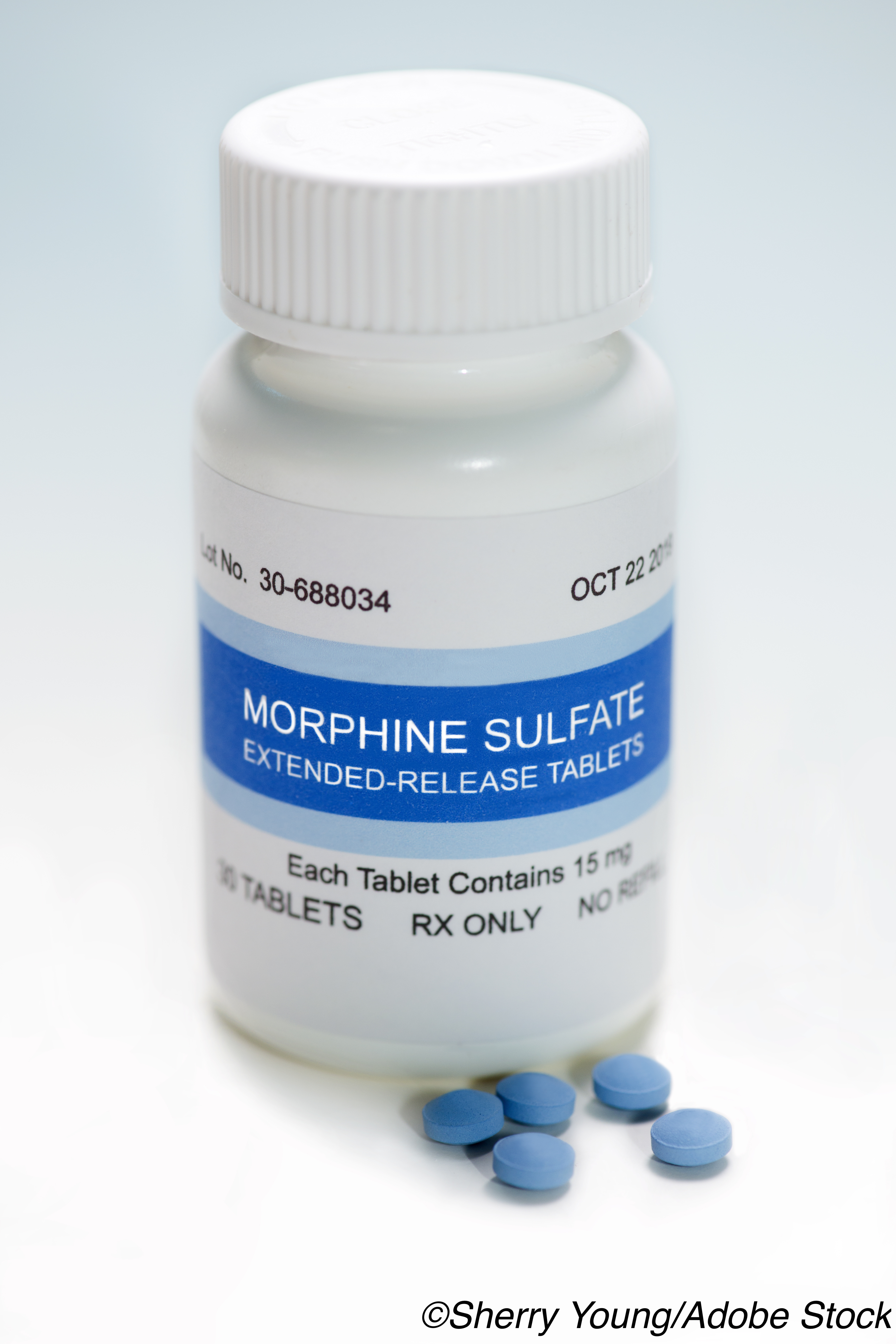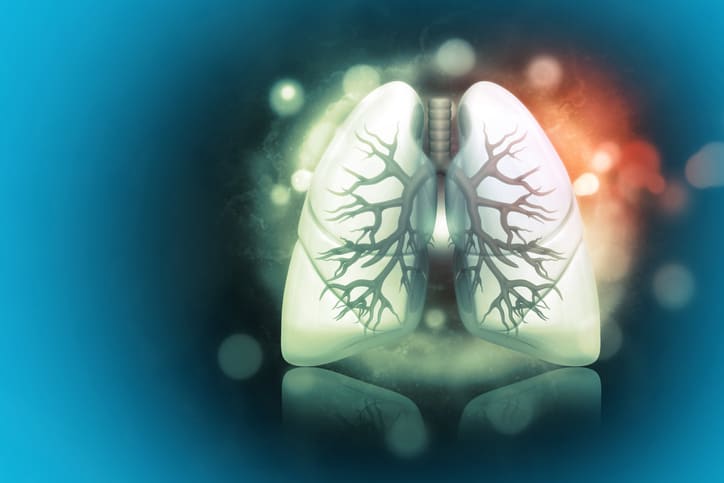 In patients with severe COPD, treatment with oral, low-dose, sustained-release morphine for 4 weeks improved health status and breathlessness in those most affected, without negatively affecting arterial partial pressure of carbon dioxide (PaCO2) levels or causing serious adverse effects, according to results from the Morphine for Treatment of Dyspnea in Patients with COPD (MORDYC) study.
In patients with severe COPD, treatment with oral, low-dose, sustained-release morphine for 4 weeks improved health status and breathlessness in those most affected, without negatively affecting arterial partial pressure of carbon dioxide (PaCO2) levels or causing serious adverse effects, according to results from the Morphine for Treatment of Dyspnea in Patients with COPD (MORDYC) study.
“Breathlessness management is an important treatment goal. Previous authors proposed palliative pharmacological treatment with low-dose opioids for patients with refractory breathlessness despite optimal pharmacological and nonpharmacological treatment. This recommendation has been included in international and national guidelines. Evidence for this recommendation is still limited,” senior author Daisy J.A. Janssen, MD, PhD, of Maastricht University, Maastricht, the Netherlands, and fellow researchers wrote in JAMA Internal Medicine.
“Moreover, physicians remain reluctant to prescribe opioids for breathlessness in COPD for fear of respiratory depression,” they added.
In the randomized, double-blind, placebo-controlled study, Janssen and colleagues sought to assess the effects of regular, low-dose, sustained-release oral morphine on disease specific health status as measured by the COPD Assessment Test (CAT), respiratory outcomes, and breathlessness. They randomized 111 patients with COPD (mean age: 65.4 years; 54% men) who had been recruited from a pulmonary rehabilitation center and two general hospitals.
Patients were randomized to either sustained-release, oral morphine (10 mg BID for 4 weeks) or placebo. They were allowed to increase to TID dosing after 1-2 weeks.
The primary outcomes of the MORDYC study were CAT scores—with higher scores representing worse health—and secondary outcomes included change in PaCO2 and breathlessness.
Compared with the placebo group, patients treated with morphine had lower CAT scores by 2.18 points (95% CI: −4.14 to −0.22 points; P=0.03).
Upon analysis of patients with modified Medical Research Council (mMRC) grades 3 to 4 despite optimal treatment, the difference in CAT scores was not significant (−1.17 points; 95% CI: −4.17 to 1.84 points; P=0.44).
Patients treated with morphine also had PaCO2 measures that were 1.19 mmHg higher (95% CI: −2.79 to 5.07; P=0.55), but this was not statistically significant. The same was true when Janssen et al analyzed patients with mMRC grade 3 to 4.
What was significantly different in favor of patients treated with morphine was the difference in respiratory rate [RR] (−1.46; 95% CI: −2.84 to −0.09; P=0.04). No difference in RR was seen, however, in the subgroup of patients with mMRC grades 3 to 4.
Although there were no between-group differences in breathlessness, patients with mMRC grades 3 to 4 with the worst breathlessness showed improvements (1.33 points lower; 95% CI: −2.50 to −0.16; P=0.03).
Researchers also found no difference in distance walked in the 6-minute walk test between the treatment groups (–5.07 m; 95% CI: −61.38 to 51.20 m; P=0.86) or in the subgroup with mMRC grades 3 to 4 (1.49 m; 95% CI: –87.47 to 90.46 m; P=0.97), or in general mobility and care dependency. The between-group differences were significant, however, for walking up the stairs or up a hill (−0.43 points; 95% CI: −0.80 to −0.07 points; P= 0.02).
Moderate-to-severe exacerbation of COPD occurred in 13% of those in the morphine group and in 19% of those in the placebo group (P=0.37). Three hospital admissions occurred (2% and 4%, respectively; P=0.59). There were no morphine-related deaths.
There were no differences in the number of patients who experienced one or more adverse effects — including nausea, vomiting/retching, drowsiness, constipation, and sleeplessness — between the morphine treatment group and placebo (81% vs 70%, respectively; P=0.18). Constipation was the only adverse effect seen significantly more in patients treated with morphine. Researchers noted that this was consistent with other studies.
Finally, more patients treated with morphine withdrew due to adverse effects compared with placebo (9% vs 2%), but there were no hospital admissions or deaths related to treatment with morphine.
Study limitations include its small size and short-term duration. Janssen and colleagues also noted that the standard exercise tests used to assess functional performance may not be appropriate at this stage of COPD. Finally, participant blinding may have been compromised by the non-blinded use of laxatives and onset of adverse effects.
In an editorial published with the story, Eric Widera, MD, of the San Francisco Veterans Affairs Health Care System, San Francisco, CA, noted that the MORDYC trial is the first clinical study of opioids for the management of breathlessness in patients with severe COPD. He added, however, that these results should be interpreted cautiously.
“Although there was a statistically significant difference in health status in favor of morphine, the clinical importance of this finding is less certain,” he wrote. “Although the trial was designed to detect a minimal clinically important difference of 3.8 points in the CAT, the authors found a difference of only 2.18. However, [Janssen] et al concluded that their findings were clinically relevant based on a 2017 study which found that the minimal clinically important difference for the CAT was between 2 and 3 points. It is reasonable to use the most current evidence to help interpret findings; however, lowering the threshold that defines a clinically meaningful difference at the end of the study suggests that the role of opioids on health status is likely small for the population studied.”
In addition, Widera added that these researchers failed to find benefits to secondary outcomes such as functional performance, care dependency, and breathlessness scores, but the latter may have been “a function of broadening the patient population to include those with less severe dyspnea.”
He noted: “If one considers only those patients with severe dyspnea (Modified Medical Research Council [mMRC] grade, ≥3), there was improvement in mean breathlessness with opioid use as well as a substantial and clinically meaningful improvement in worst breathlessness scores.”
“For patients whose breathlessness remains refractory and severe (mMRC grade 3 or 4), most of the evidence over the last 4 decades has demonstrated that carefully prescribed low-dose opioids can yield a small yet clinically important improvement in breathlessness for individuals with advanced COPD,” Widera concluded.
-
Regular treatment with low-dose, oral, sustained-release morphine improved disease-specific health status in patients with COPD without negative effects on PaCO2 or serious adverse effects, according to results from the MORDYC study.
-
In patients with advanced, severe COPD, short-term, low-dose morphine brought about a small but clinically meaningful improvement in breathlessness.
E.C. Meszaros, Contributing Writer, BreakingMED™
This study was supported by the Netherlands Organization for Health Research and Development.
Janssen has received person fees from Boehringer, Novartis, and AstraZeneca outside this study.
Widera reported no disclosures.
Cat ID: 154
Topic ID: 89,154,730,143,192,154,195,925


